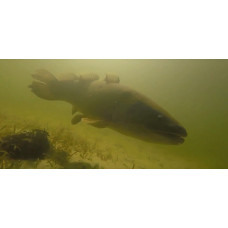Amiidae is a family of fishes of the order Amiiformes. It includes one genus Amia with a single representative - Amia calva. The body is elongated, covered with cycloid scales. Reaches 90 cm in length. The axial skeleton is bony. The dorsal fin is long. Swim bladder with cellular walls, serves as an additional respiratory organ. Breathing by means of gills and swim bladder. Inhabits in fresh waters of rivers and lakes in North America. Spends the winter in deep places in a state close to hibernation. Predator. Feeds mainly on fish, to a lesser extent - crayfish and mollusks. Fishery value is not great).
Fishes of this family are characterized by the presence of many features peculiar to bony fishes, but at the same time they retain a number of archaic features. Their body is covered with thick overlapping cycloid scales, devoid of ganoin. Remains of a spiral valve in the intestine are preserved. Cellular swim bladder is connected by a duct to the upper wall of the pharynx and functions as a lung, which allows the ooze fish to live in water bodies almost deprived of oxygen, and to remain viable outside the water for a day. Along with the numerous rays of the gill membrane, an unpaired throat gular plate is retained. The jaws bear strong conical teeth. The spine is completely ossified; the vertebral bodies are biconcave (amphicel). There is an intercranial bone. The caudal fin is shortened heterocercal.
The only representative of the Amia family is the ooze fish (Amia calva). Its length reaches up to 90 cm, but usually does not exceed 60 cm. It is colored dark olive on top, light underneath, and the sides are covered with interspersed light and darker greenish spots. There is a round black spot in the upper part of the tail stalk. In males, it is surrounded by an orange or yellow border, while in females this border is absent and the spot itself is sometimes absent. The fins are greenish in color. Very characteristic of the ooze fish presence of a long dorsal fin, extending from the front of the body to the high tail stem. The caudal fin is rounded. The paired fins are small, without fleshy bases. The pelvic fins are abdominal, sitting on the middle of the abdomen. The short anal fin is somewhat closer to the pelvic fins than to the tail.
It lives in the Mississippi basin and in Lakes Huron and Erie, preferring standing or low-flow waters with flat, heavily overgrown bottoms. It does not avoid swampy water bodies where oxygen deficiency is often observed, as it is able to breathe atmospheric air. It is mainly nocturnal, hunting in shallow water thickets of aquatic vegetation, and during the day it prefers deeper places. Here it also goes in winter, where it falls into a state close to hibernation.
Spawning occurs in summer, when the water warms up to 25 ° C. By the time of spawning, the male, which appears mating attire, builds a saucer-shaped nest of aquatic plants about 40x60 cm in size. These nests are built in shallow water, in the coastal zone of rivers and lakes, among aquatic vegetation at a depth of 25-40 cm. Nest construction and spawning take place at night. Fecundity of the oily fish reaches 70 thousand eggs. The eggs deposited in the nest are guarded by the male. Often many nests are located next to each other, forming nesting colonies, which facilitates their protection. The incubation period lasts 8-10 days. The newly hatched larvae are suspended on the nest walls by an adhesive "suction cup" located on the snout. They spend about 10 days in this position until the yolk sac dissolves, after which they begin to feed actively. By this time they leave the nest and swim in a flock guarded by the male. Young fish grow very fast and reach a length of 13-22 cm in a year. Since the sludge fish is characterized by voracity and indiscriminate eating, destroying all available to it fish and invertebrates, it is considered a very harmful predator. Where it is particularly abundant, measures are taken to eradicate it. It is only eaten in the southern states.
Amiidae
Tags: amiidae



